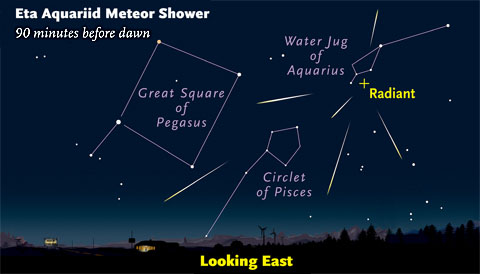If you'd like to see bits of debris shed by Halley's Comet, then head out before dawn during the next few days.
Only one major meteor stream, the one shed by Comet 1P/Halley, intersects Earth's orbit in two places such that both resulting showers are visible at night. In October we call them the Orionids, and in May they're the Eta Aquariids.
Both showers run for several days and have a reputation for meteors that are swift and relatively faint. But in May we apparently pass nearer to the center of the stream; the Eta Aquariid shower is roughly three times as strong as the Orionid shower, and it lasts longer too.

Sky & Telescope diagram
This year the Eta Aquariid shower is set to peak on the mornings of May 5th and 6th, when its meteors will be untroubled by moonlight.
The Eta Aquariid meteor shower is usually the year's best for those living in the Southern Hemisphere, with perhaps 60 "shooting stars" visible per hour before dawn to an observer with ideal conditions. Meteor watchers in northern latitudes see fewer, and those north of 40° or 45° see hardly any, because the shower's radiant (at the Water Jug or Jar, the head of Aquarius) is still low in the east-southeast as dawn brightens.
On the other hand, when a shower's radiant is low, the few meteors that do show up tend to be long, dramatic Earthgrazers passing far across the sky. That seems somehow fitting for dusty bits cast into space by none other than Halley's Comet.
 7
7
Comments
cocoida
May 5, 2016 at 5:23 am
Trying to observe meteor eta aquariid in southern hemisphere (Louisiana), @4:30-5:30 am May 5th&6th. Looking to my east and facing e/ne on this May5th morning will you be able to verify if I will be successful in seeing without a telescope??? I.C.in NOLA
You must be logged in to post a comment.
Enrique Ferriño
May 7, 2016 at 12:03 pm
Louisiana is not in the southern hemisphere...
You must be logged in to post a comment.
Tom Hoffelder
May 5, 2016 at 10:41 am
It is important to note that "ideal conditions" equals ZHR, Zenith Hourly Rate, which is the number of meteors seen per hour if the radiant was at the zenith. Since the radiant remains low until twilight interferes, the best that can be expected is about half of the ZHR, or 30/hr. Per the AMS info for this week: "During this period the Eta Aquariids are at their best, capable of producing zenith hourly rates (ZHRs) of 60. The actual visible rates are most often less than half this figure due to the low altitude of the radiant at dawn. Observed hourly rates at maximum normally vary from zero at 60 degrees north latitude to 30 near the equator and back down to near zero again in Antarctica..."
You must be logged in to post a comment.
Bob
May 5, 2016 at 2:34 pm
rocksnstars...
Thanks for posting about the ZHR, Zenith Hourly Rate.
You must be logged in to post a comment.
Jaybird
May 6, 2016 at 5:36 am
Still Look in in southeast lower mi.
You must be logged in to post a comment.
Jaybird
May 6, 2016 at 5:54 am
0 sighted
You must be logged in to post a comment.
May 7, 2016 at 12:06 pm
Shower remains active this morning. I was out at 09:15 UT, and saw a swift, 2.5 magnitude Eta Aquariid low in the NE sky, while enjoying the morning stars and calls of the Whip-poor-wills.
DZ
You must be logged in to post a comment.
You must be logged in to post a comment.